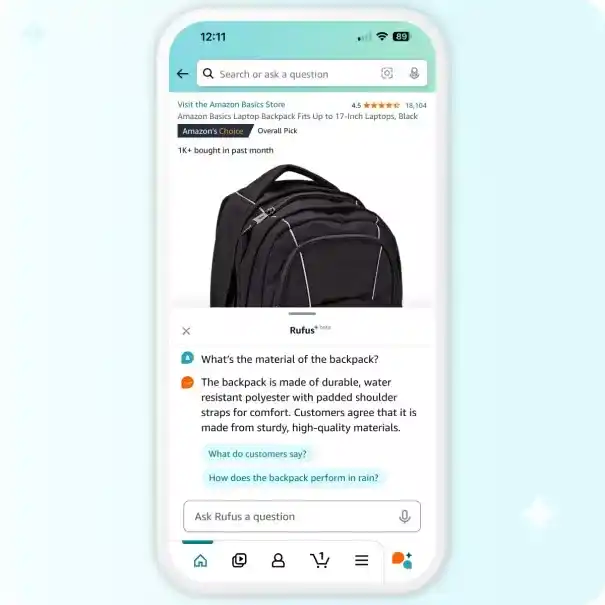Table of Contents
Amazon AI Chatbot Rufus, Amazon has unveiled its AI-powered shopping assistant, Rufus, to all U.S. customers within the Amazon mobile app. This innovative assistant, prominently located at the bottom right of the app’s main navigation bar, is designed to enhance the shopping experience by helping users find products, perform product comparisons, and receive personalized recommendations.
Introduction of Amazon AI Chatbot Rufus
Initially, Amazon’s AI-powered chatbot Rufus was accessible only to a small set of U.S. users as part of a beta testing phase. This limited rollout was designed to ensure that Rufus could be fine-tuned based on real user interactions and feedback before being made available to a broader audience. During this beta phase, Rufus was rigorously tested to handle a wide variety of customer inquiries and tasks, ranging from finding products to providing personalized recommendations and making product comparisons. The goal was to refine its natural language processing capabilities and ensure it could deliver accurate, relevant, and helpful responses.
The feedback from beta users was instrumental in shaping Rufus’s development. Amazon closely monitored how users interacted with the chatbot, noting common queries, user behavior patterns, and any issues that arose. This allowed the development team to make necessary adjustments and improvements, ensuring that Rufus became more efficient and user-friendly with each iteration. Beta users were able to ask Rufus tens of millions of questions, providing a robust data set that Amazon used to train and enhance the AI’s algorithms.

The extensive testing and feedback loop proved successful, as Rufus demonstrated its capability and reliability by effectively handling a vast array of inquiries. Amazon reported that Rufus not only managed to provide satisfactory responses to these questions but also showcased an impressive ability to learn and adapt. This iterative process of learning from real-world interactions helped Rufus become a more polished and reliable tool, ready for a wider rollout.
Following this successful beta phase, Amazon decided to make Rufus accessible to all U.S. shoppers. This marked a significant milestone, as the chatbot had proven its value and effectiveness. Now, with Rufus available to all users, Amazon aims to provide an enhanced shopping experience, leveraging the power of AI to assist customers in a more intuitive and personalized manner. The extensive beta testing phase has ensured that Rufus is well-equipped to meet the diverse needs of Amazon’s vast customer base, making it a reliable and valuable addition to the Amazon mobile app.
Training and Data Sources
Announced in February, Rufus has been meticulously trained on Amazon’s comprehensive product catalog, customer reviews, community Q&As, and other publicly available information from the web. Although Amazon AI chatbot Rufus has not specified which external websites were used, the data integration ensures that Rufus delivers accurate and insightful recommendations.
Key Features of Amazon AI Chatbot Rufus
Advanced Large Language Model (LLM)
Rufus is powered by an internal large language model specialized for shopping. This enables customers to ask detailed questions about products, such as considerations when buying specific items, differences between products, and product durability based on customer reviews and expert analysis.
Example Interactions
Customers can ask Rufus various questions like:
- “What to consider when buying headphones?”
- “What are clean beauty products?”
- “What do I need for cold weather golf?”
Rufus also responds to broader requests, such as, “I want to start an indoor garden,” by providing tailored product suggestions to achieve the customer’s goals.

Interactive and Intuitive
During the testing phase, Amazon AI Chatbot Rufus discovered that users frequently engaged with Rufus by clicking on related questions that appeared in the chat window. For example, a customer might inquire about the material of a backpack and then follow up by asking, “What do customers say?” to gather more information. Rufus’s understanding extends beyond products; it can provide contextual information such as weather conditions in specific locations, enhancing the relevance of its recommendations.
Keeping Customers Updated
Rufus not only helps with product comparisons but also keeps customers informed about the latest trends in fashion and technology. Users can ask about the newest models or popular styles, ensuring they stay up-to-date with current trends.
Order Assistance
In addition to shopping assistance, Rufus can help customers find their past orders and provide updates on the status of current orders. This feature adds a layer of convenience for users managing multiple purchases.
Accessing Amazon AI Chatbot Rufus
To use Rufus, U.S. customers need to have the latest version of the Amazon Shopping app installed. The assistant can be accessed from the bottom navigation bar, marked by an icon featuring chat bubbles with a sparkle.
Conclusion
The launch of Rufus marks a significant advancement in Amazon’s use of artificial intelligence to improve customer service and the shopping experience. With its ability to provide detailed product information, personalized recommendations, and order management assistance, Rufus stands out as a powerful tool for Amazon customers. As Rufus continues to evolve and integrate more features, it promises to further enhance the convenience and efficiency of shopping on Amazon.
Amazon AI Chatbot Rufus is not just a technological innovation; it’s a step towards a more interactive, intuitive, and personalized shopping experience for all users. Embrace the future of shopping with Rufus, now live for all U.S. customers.